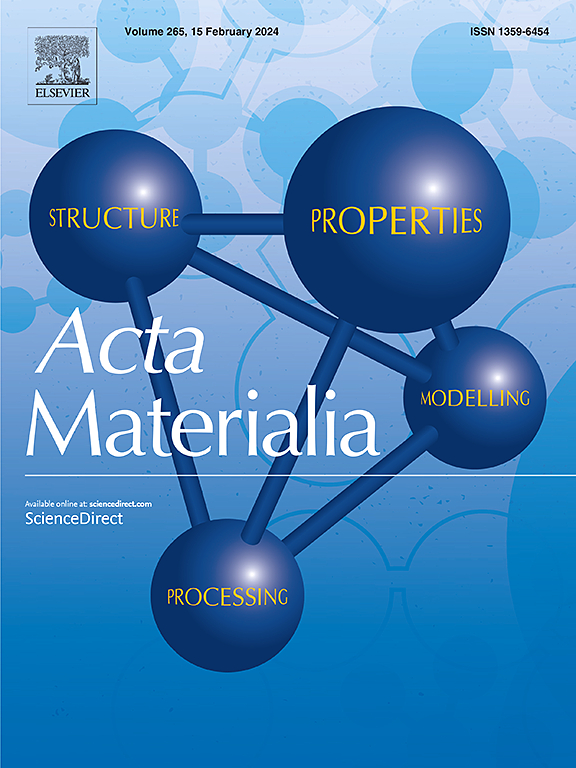Capillary shrinkage induced ductile–brittle transition in nanoporous gold: Crack healing via cold welding
IF 8.3
1区 材料科学
Q1 MATERIALS SCIENCE, MULTIDISCIPLINARY
引用次数: 0
Abstract
When a brittle nanoporous material infiltrated with water is dried in air, the capillarity-induced large volume shrinkage often leads to cracking within the material. In consequence, porous material may become more fragile or even shatter after drying. In this paper, we prepared nanoporous gold (NPG) with a low relative density by dealloying dilute Ag(Au) precursor alloys. Drying of this sample in air leads to a large volume contraction up to 2238%. Meanwhile, the material undergoes a ductile–brittle transition during drying: The wet sample of as-dealloyed NPG, while tested in water, shows a surprisingly large tensile strain up to 8%–10% before fracture; After drying, the fracture strain of the same material drops to around 1% in tension. This ductile-to-brittle transition is not caused by the formation of cracks as usual. Instead, it can be linked to the self-healing of microcracks during drying. We found that the plasticity of as-dealloyed NPG arises from the presence of high-density native microcracks. The bridging or deflection of these microcracks in tension leads to a diffuse failure, which accounts for the large irreversible tensile strain of the wet, as-dealloyed NPG. Further examination reveals that these native microcracks can be healed during drying, owing to the cold welding of nano-ligaments under capillary contraction force. Healing of these microcracks suppresses the diffuse failure induced by crack bridging or deflection, leading to a brittle fracture of the dried NPG in tension. Cold welding of nano-ligaments, which accounts for the anomalous crack healing and ductile–brittle transition of NPG in drying, might occur frequently in nanoporous metals under external load and contribute significantly to their mechanical performance.


纳米孔金中毛细收缩诱导的韧脆转变:冷焊裂纹修复
当一种易碎的纳米多孔材料浸水在空气中干燥时,毛细作用引起的大体积收缩往往导致材料内部开裂。因此,多孔材料在干燥后可能变得更加脆弱甚至破碎。本文通过对稀银(Au)前驱体合金进行脱合金处理,制备了低相对密度的纳米孔(np) Au。该样品在空气中干燥后,体积收缩可达22 ~ ~ 38%。与此同时,材料在干燥过程中经历了韧脆转变:在水中测试时,湿样的as- alloy np Au在断裂前表现出惊人的8%-10%的拉伸应变;干燥后,同一材料的断裂应变降至张力的1%左右。这种从韧性到脆性的转变不是通常由裂纹的形成引起的。相反,它可以与干燥过程中微裂纹的自愈联系在一起。我们发现,合金的塑性是由高密度的原生微裂纹引起的。这些微裂纹在拉伸作用下的桥接或挠曲导致弥漫性破坏,这是湿的、合金化的np Au具有较大不可逆拉伸应变的原因。进一步研究表明,由于纳米韧带在毛细收缩力的作用下进行冷焊,这些天然微裂纹可以在干燥过程中愈合。这些微裂纹的愈合抑制了由裂纹桥接或挠曲引起的弥散破坏,导致干燥的np金在张力下发生脆性断裂。纳米韧带的冷焊是np金属在外部载荷作用下经常发生的现象,是np金属在干燥过程中裂纹异常愈合和韧脆转变的原因,对其力学性能有重要影响。
本文章由计算机程序翻译,如有差异,请以英文原文为准。
求助全文
约1分钟内获得全文
求助全文
来源期刊

Acta Materialia
工程技术-材料科学:综合
CiteScore
16.10
自引率
8.50%
发文量
801
审稿时长
53 days
期刊介绍:
Acta Materialia serves as a platform for publishing full-length, original papers and commissioned overviews that contribute to a profound understanding of the correlation between the processing, structure, and properties of inorganic materials. The journal seeks papers with high impact potential or those that significantly propel the field forward. The scope includes the atomic and molecular arrangements, chemical and electronic structures, and microstructure of materials, focusing on their mechanical or functional behavior across all length scales, including nanostructures.
 求助内容:
求助内容: 应助结果提醒方式:
应助结果提醒方式:


